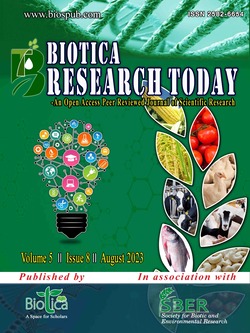
Molsari: A Panacea Drug for Conventional Therapy
Maneesh Kumar*
Dept. of Horticulture, College of Agriculture, G.B. Pant University of Agriculture and Technology, Pantnagar, Uttarakhand (263 145), India
V.P. Singh
Dept. of Horticulture, College of Agriculture, G.B. Pant University of Agriculture and Technology, Pantnagar, Uttarakhand (263 145), India
Jaspreet Kaur
Dept. of Horticulture, College of Agriculture, G.B. Pant University of Agriculture and Technology, Pantnagar, Uttarakhand (263 145), India
Sajeel Ahamad
Division of Food Science & Post-harvest Technology, Indian Agricultural Research Institute, New Delhi (110 012), India
Mandeep Rawat
Dept. of Horticulture, College of Agriculture, G.B. Pant University of Agriculture and Technology, Pantnagar, Uttarakhand (263 145), India
DOI: NIL
Keywords: Ayurvedic, Conventional therapy, Medicinal value, Molsari
Abstract
Molsari is a one of the most ancient medicinal plant known to mankind. It is an evergreen, medium-long size tree known by various vernacular names. It is an Indian origin plant and is mainly grown in Madhya Pradesh, Bihar, Uttar Pradesh, Jammu and Andaman Island. The plant contains various glycosides, steroids and chemical compounds which are used extensively in pharmaceutical industry and traditional therapy. Molsari is also a significant ingredient for several traditional Unani and Homeopathic medicines. The fruits of molsari are somewhat resemble like date palm with incredible remedial value and can eaten as a ripe raw fruit. As the human lifestyle is changing and demand for medicines increasing, therefore with increasing demand there is immense scope for future research in its medicinal properties in traditional or Ayurvedic medicine systems as well as allopathy, owing to its excellent medicinal worth.
Downloads
not found
Reference
Bhujbal, S.S., Deshmukh, R.P., Bidkar, J.S., Thatte, V.A., Awasare, S.S., Garg, P.P., 2011. Evaluation of cytotoxic activity of barks of Mimusops elengi. Europian Asian Journal of BioSciences 5(2), 73-79.
Gami, B., Parabia, M., Kothari, I.L., 2010. In vitro development of callus from node of Mimusops elengi- as substitute of natural bark. International Journal of Pharmaceutical Sciences and Drug Research 2(4), 281-285.
Gami, B., Pathak, S., Parabia, M., 2012. Ethnobotanical, phytochemical and pharmacological review of Mimusops elengi Linn. Asian Pacific Journal of Tropical Biomedicine 2(9), 743-748. DOI: https://doi.org/10.1016%2FS2221-1691(12)60221-4.
Rani, S., Rahman, K., 2017. Molsari (Mimusops elengi linn.): A boon drug of traditional medicine. International Journal of Pharmaceutical Sciences and Research 8(1), 17-28. DOI: https://doi.org/10.13040/IJPSR.0975-8232.8(1).17-28.
Shah, P.J., Gandhi, M.S., Shah, M.B., Goswami, S.S., Santani, D., 2003. Study of Mimusops elengi bark in experimental gastric ulcers. Journal of Ethnopharmacology 89(2-3), 305-11. DOI: https://doi.org/10.1016/j.jep.2003.09.003.
